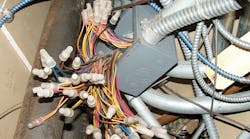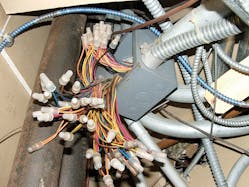How well do you know the Code? Think you can spot violations the original installer either ignored or couldn't identify? Here's your chance to moonlight as an electrical inspector and second-guess someone else's work from the safety of your living room or office. It's your turn to identify the violation.
Hint: Botched box installation
August Winners
Our three winners this month were: Dave Blasing, a self-employed master electrician at Blasing Electric in Janesville, Minn.; Jimmy Fleming, president of Jimmy Fleming Electric, LLC, Chatham, N.J.; and Robert Germain, owner of Robco Electric in Phoenix. Each one of them knew there were several problems with this outdoor installation, including the way in which the PVC pipe has pulled away from the panelboard enclosure.
Section 352.20 requires PVC to be installed and fastened in a manner that allows movement from thermal expansion and contraction. When that movement causes the pipe to separate from an enclosure, something was not done correctly during the installation. Perhaps an expansion fitting or a flexible fitting could have been used to accommodate this movement.
The missing cover for the panelboard enclosure on the right is a violation of Sec. 312.2. This “weatherproof” enclosure is not very weatherproof with its cover missing. The circuit breakers are now directly exposed to rain, snow, and other damaging environmental conditions. Section 240.32 also requires this circuit breaker enclosure to comply with Sec. 312.2 when installed in a damp or wet location.
Another problem I would like to point out is the lack of a circuit directory or circuit identification for the breakers in the panelboard, as required by Sec. 408.4(A).






